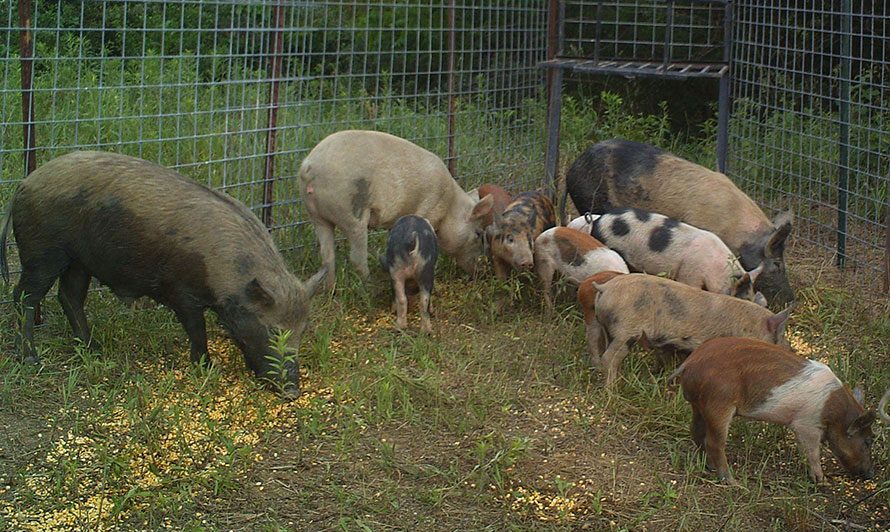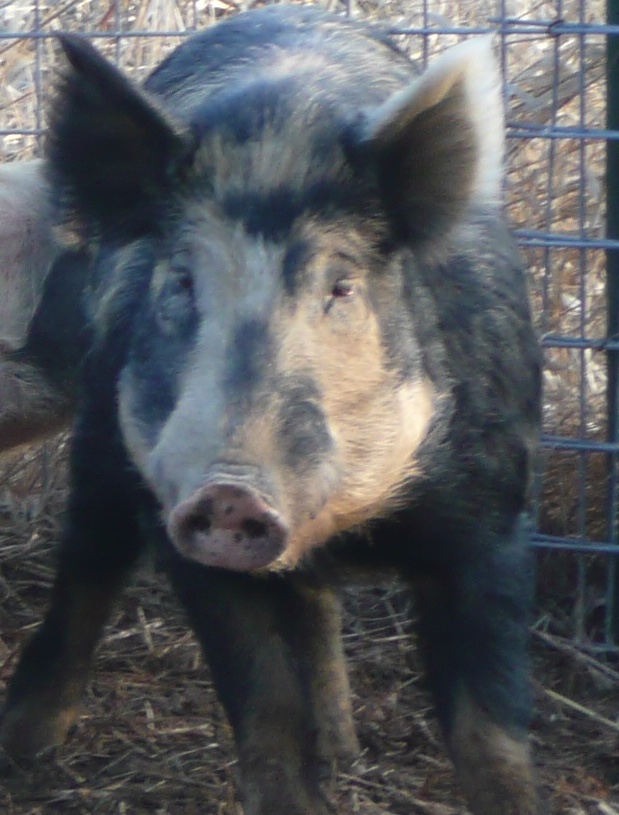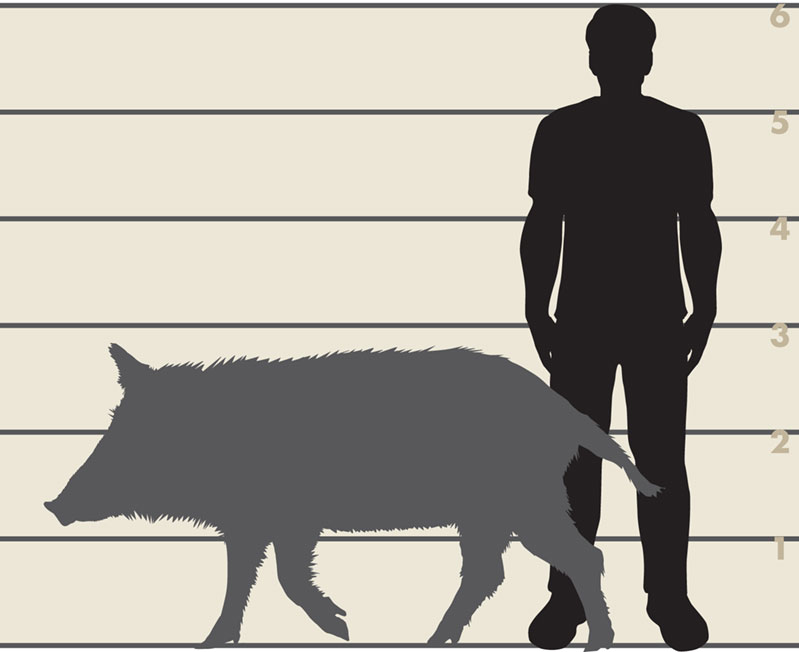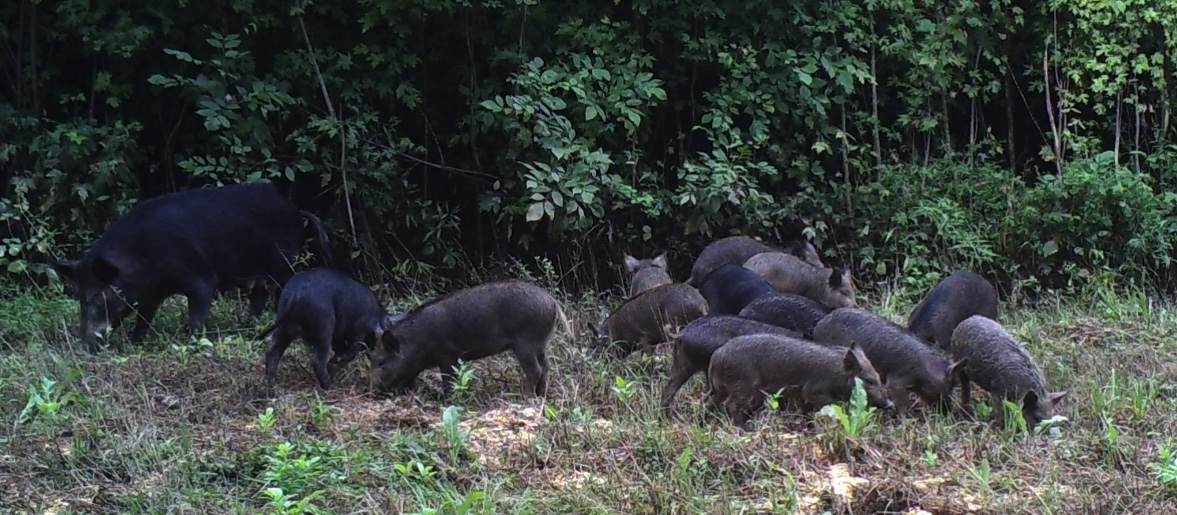
Photo: USDA Wildlife Services
To report a recent feral swine sighting in Illinois go to: https://wildlifeillinois.org/sightings/report-feral-swine-sightings/
Learn more about feral swine in Illinois in OutdoorIllinois Journal:
Targeting Feral Swine in Illinois: Part 2—Developing and Implementing a Feral Swine Management Plan
Targeting Feral Swine in Illinois: Part 3—Lessons Learned from Managing Feral Swine in Illinois
Targeting Feral Swine in Illinois: Part 4—Illinois Feral Swine Laws
In Illinois, wild swine are defined as feral swine, Eurasian wild boar (Sus scrofa, including subspecies), and hybrids between feral swine and Eurasian wild boar. Populations or individuals of domesticated swine that are not clearly identified by ear tags or other identification, are unrestrained and free-roaming, and have adapted to living in the wild are considered feral swine.
Feral swine are similar in appearance to domestic swine, though generally thinner in shape, with a thicker coat and longer canine teeth (called tusks). Feral swine come in a variety of colors, including combinations of black, white, red, brown, or belted. As with color, size can be highly variable. Feral swine can reach three feet in height at the shoulder, five feet in length, and exceed 300 pounds in weight. In Illinois, the average sow weighs approximately 130 pounds while the average boar weighs 220 pounds.
Feral swine have small eyes, large triangular ears, and a long snout ending in a large round nose. They typically have a thick coat of coarse bristly hair, most having longer bristles than their domestic ancestors, but shorter hair than purebred Russian boars. Boars develop a thick, tough layer of cartilage over the shoulders called a shield and have four sharp tusks that can reach five inches in length. The bottom tusks are formidable weapons used for defense and to establish dominance during breeding
Tracks of feral swine are similar in appearance to deer tracks, but the toes of feral swine appear blunt or rounded compared to the pointed toes of deer. Feral swine tracks have a square shape whereas deer tracks have a heart shape.
The droppings of feral swine is similar in appearance to deer droppings; however, the pellets are larger and more variable in shape and content. Scat may contain grain, acorns, and the hair or feathers of consumed animals or birds.
Feral swine can live in a variety of habitats, including dense forest and open grassland areas with mixed agriculture. They prefer moist bottomland forests and areas around streams and creeks where mud for wallowing is available.
Feral swine are opportunistic in their food selection and will eat just about anything with nutritional value. Their diet varies with the seasons and reflects the available food sources. Food items include grasses, roots, tubers, shoots, acorns, fruits, berries, earthworms, amphibians, reptiles, rodents, birds, carrion, and newborn white-tailed deer. In agricultural areas, wild hogs will consume cultivated crops and young livestock.
Feral swine can breed year-round and can have up to two litters per year. Litter size ranges from 5 to 10 piglets. A wild pig can become sexually mature at six months of age. Feral swine populations have the potential to double in size in four months.
Feral swine live four to five years, on average, but have been known to live up to eight years, though a large percentage of piglets die within the first three months of age. Mortality factors include disease, hunting, and predation from coyotes, bobcats, or feral dogs. Adult feral swine have no natural predators in Illinois.
Feral swine are highly social and travel in family groups (called “sounders”) composed of several sows and their young. Weaned pigs remain with their mother until she has another litter or until they mate. Boars remain solitary or in bachelor groups, except during breeding when they will join the female groups.
The home range of feral swine varies, dependent on the availability of food, water, and cover. Abundant resources result in a smaller home range. The range of boars can be as much as 15 square miles when resources are scarce. Females generally use an area that is two to five square miles.
During the summer months, feral swine are most active at night. Activity patterns shift to early morning and late afternoon when temperatures cool from fall through spring.
Feral swine often feed by rooting in moist soil and can literally plow the soil to depths of up to 12 inches in search of favored food items. They will cool themselves in “wallows”—moist areas near seeps, springs, ponds, or streams. Feral swine often rub on nearby trees and posts leaving mud and hair.
Feral swine may carry more than 30 diseases and 30 species of parasites, many of which are transmissible to people, pets, wildlife, and livestock. Those that often impact people include brucellosis, E. coli, Salmonella, swine influenza, and trichinellosis.
Care should be taken while field dressing harvested feral swine and/or processing and cooking pork from feral swine. For more information, click HERE.
Feral swine are a threat to both native wildlife and plant communities as well as to agricultural crops and livestock. Feral swine carry diseases that affect domestic swine, including classical swine fever, pseudorabies, and tularemia.
A variety of control measures must be used; however, techniques that remove a large percentage of the existing population are more effective than those that remove only a few individuals at a time.
Shooting can be an effective control measure only when a few individuals are present. Shooting into large groups can disrupt the social organization of the sounder and disperse the animals across the landscape. Shooting can be very detrimental in areas where organized feral swine control efforts are underway.
Trapping using large corral-type traps is a more effective and efficient control strategy where large populations of feral swine are present. Large corral-type traps, strategically triggered, have the capacity to capture most if not all of the individuals in a sounder, which maximizes hog removals while minimizing dispersal.
The Illinois Department of Natural Resources is working cooperatively with USDA APHIS Wildlife Services to provide assistance in the removal of feral swine. These services are provided at no cost to the landowner. Request a permit from your local District Wildlife Biologist or call the Wildlife Disease and Invasive Species program at 815-369-2414 or USDA APHIS Wildlife Services at 866-487-3297 for information about the assistance program.
In Illinois, feral swine are classified as invasive, exotic, wild animals and are regulated by the Illinois Department of Natural Resources. It is illegal to release or transport feral swine in Illinois. Guiding or hunting within an enclosure is also prohibited. Hunting of feral swine is only allowed during the firearm deer seasons, including the late winter and chronic wasting disease seasons. Hunters are required to report harvested feral swine by calling 815-369-2414.
Landowners wishing to remove feral swine from their property must obtain a nuisance animal removal permit by contacting their local IDNR District Wildlife Biologist, the Wildlife Disease and Invasive Species Program (815-369-2414), or USDA APHIS Wildlife Services (866-487-3297).
United States Department of Agriculture, Animal and Plant Health Inspection Service, Wildlife Services: Feral Swine homepage
United States Department of Agriculture, Animal and Plant Health Inspection Service, Wildlife Services: Feral Swine Resources and Outreach Materials
Illinois Department of Natural Resources: Feral Swine

Photo: USDA Wildlife Services

Photo: USDA Wildlife Services


Photo: USDA Wildlife Services
The Wildlife Illinois website was authorized by the Illinois Department of Natural Resources (IDNR) in partial fulfillment of project W-147-T. The website was developed by the National Great Rivers Research and Education Center, 2wav, and the IDNR in partnership with the United States Department of Agriculture Animal and Plant Health Inspection Service Wildlife Services and University of Illinois Extension to provide research-based information about how to coexist with Illinois wildlife.